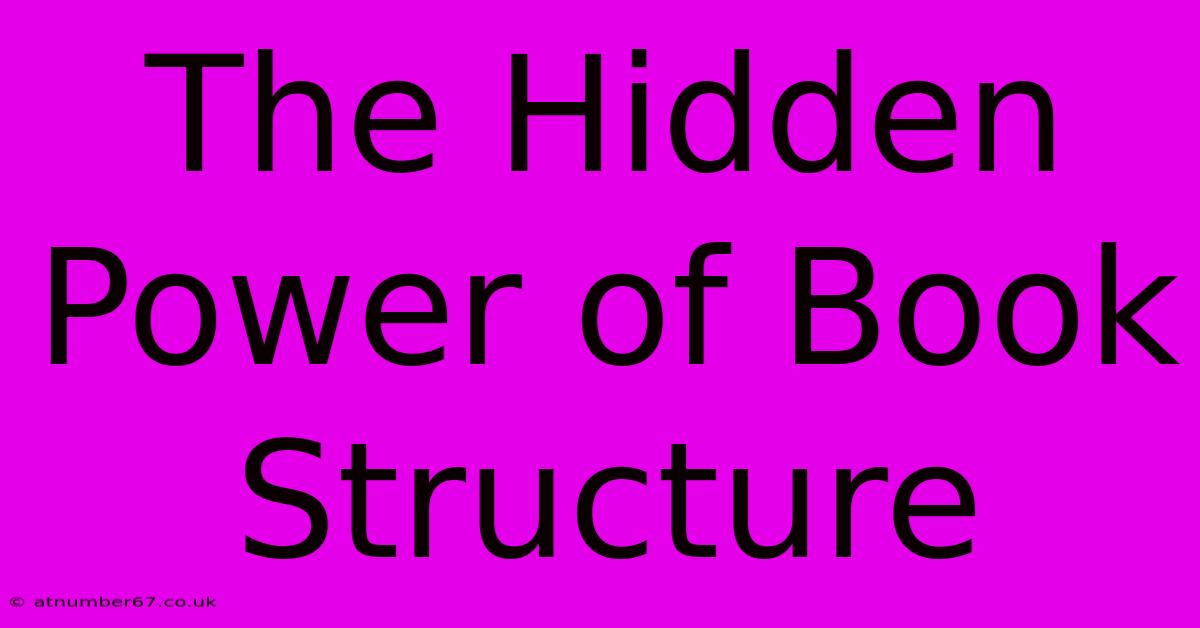The Hidden Power Of Book Structure

Table of Contents
The Hidden Power of Book Structure: How Organization Impacts Readability and Success
Have you ever started reading a book, only to find yourself struggling to stay engaged? The writing might be beautiful, the characters compelling, but something feels…off. The culprit might not be the content itself, but the underlying book structure. A well-structured book isn't just aesthetically pleasing; it's the hidden power behind a truly captivating and successful read. It's the scaffolding that supports the weight of your narrative, ensuring a smooth and satisfying reading experience for your audience. This article will delve into the crucial elements of effective book structure and how mastering it can elevate your writing to new heights.
Understanding the Importance of Book Structure
Think of your book's structure as a blueprint. Just as a poorly designed building is unstable and unappealing, a poorly structured book can leave readers feeling lost and frustrated. A strong structure provides:
- Clarity: Readers easily understand the flow of the story and the relationships between different parts.
- Engagement: A well-paced narrative keeps readers hooked, preventing them from abandoning the book mid-way.
- Impact: A meticulously crafted structure allows your message to resonate deeply with the reader, leaving a lasting impression.
- Credibility: A professional and well-organized book enhances your credibility as an author.
Key Elements of Effective Book Structure
Several key elements contribute to a powerful book structure:
1. Plot Structure: The Foundation of Your Story
The most fundamental aspect is your plot structure. Familiarizing yourself with established structures like the three-act structure (setup, confrontation, resolution), Freytag's pyramid, or even more unconventional approaches is essential. Choosing the right structure depends heavily on your genre and story. A compelling plot keeps readers engaged from beginning to end.
2. Pacing: The Rhythm of Your Narrative
Pacing refers to the speed at which the story unfolds. Mastering pacing involves strategically placing moments of high tension alongside periods of reflection or exposition. A well-paced book avoids feeling rushed or dragging.
3. Chapter Structure: Breaking Down Your Narrative
Individual chapters are building blocks of your larger structure. Each chapter should have a clear purpose, contributing to the overall narrative arc. Varying chapter lengths can help control pacing and create a dynamic reading experience. Consider using short chapters for action scenes and longer chapters for character development or exposition.
4. Point of View: Choosing Your Narrative Lens
Your point of view (first-person, third-person limited, third-person omniscient) significantly impacts the reader's experience. The chosen POV dictates the information revealed and the reader's emotional connection to the characters. Choosing the right POV is crucial to effectively convey your story.
5. Scene Structure: Crafting Individual Moments
Even within chapters, scene structure matters. Each scene should have a clear beginning, middle, and end, contributing to the overall chapter's purpose. This micro-level structure keeps each individual scene impactful and prevents it from feeling disjointed or rambling.
Beyond the Basics: Advanced Structural Techniques
Beyond the fundamental elements, consider these advanced techniques to further enhance your book's structure:
- Flashback and Foreshadowing: Strategic use of these techniques can build suspense and deepen the reader's understanding of the characters and plot.
- Subplots: Well-integrated subplots add complexity and richness to your narrative, providing additional layers of interest.
- Parallel Plots: Telling multiple stories simultaneously can create a compelling and layered narrative, but requires careful planning and execution.
The Impact of a Strong Book Structure on Success
A well-structured book is more likely to:
- Attract and retain readers: Readers are more likely to finish and recommend a book that is easy to follow and engaging.
- Receive positive reviews: Reviewers appreciate a well-crafted narrative that is both enjoyable and impactful.
- Achieve higher sales: A compelling and well-structured book is more likely to sell well.
In conclusion, mastering book structure is not merely a technical exercise; it's the key to unlocking the full potential of your storytelling. By carefully considering the elements outlined above, you can create a book that is not only well-written but also deeply engaging and profoundly impactful for your readers. Investing time in planning and revising your book's structure is an investment in its overall success.

Thank you for visiting our website wich cover about The Hidden Power Of Book Structure. We hope the information provided has been useful to you. Feel free to contact us if you have any questions or need further assistance. See you next time and dont miss to bookmark.
Featured Posts
-
Dragon Age Veilguard Unbreakable Bonds
Apr 13, 2025
-
Rare Insights How Many Daughters Did Prophet Muhammad Possess
Apr 13, 2025
-
Inner Child Healing A Journey To Self Acceptance
Apr 13, 2025
-
Billy Corgan S Financial Empire A Close Look
Apr 13, 2025
-
Unmasking Mikey Madisons Millions Net Worth Secrets Exposed
Apr 13, 2025
